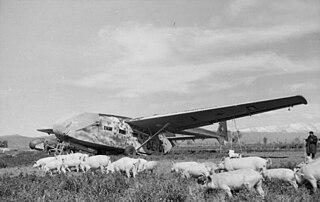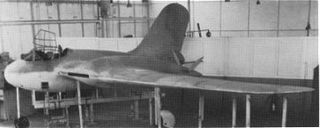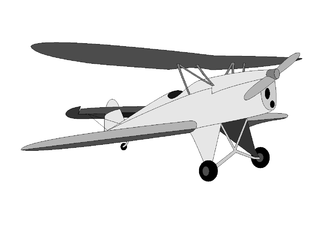
The Messerschmitt Me 328 was originally designed as a parasite aircraft to protect Luftwaffe bomber formations during World War II. During its protracted development, a wide variety of other roles were suggested for it. Late in the war, the design was resurrected for consideration as a Selbstopfer aircraft, but was judged unsuitable even for this purpose. The tiny fighter was to have been propelled by pulsejets, but the unsuitability of these engines doomed the Me 328 from the start.

The Göppingen Gö 9 was a German research aircraft built to investigate the practicalities of powering a plane using a pusher propeller located far from the engine and turned by a long driveshaft.

The Messerschmitt Me 321 Gigant was a large German cargo glider developed and used during World War II. Intended to support large scale invasions, the Me 321 saw very limited use due to the low availability of suitable tug aircraft, high vulnerability whilst in flight and the difficult ground handling, both at base and at destination landing sites. The Me 321 was developed, in stages, into the six-engined Messerschmitt Me 323 Gigant, which removed some of the problems with ground handling, but vulnerability to ground fire and aerial attack remained a constant problem during operations of all variants.

The Gotha Go 242 was a transport glider used by the Luftwaffe during World War II. It was an upgrade over the DFS 230 in both cargo/troop capacity and flight characteristics. It saw limited combat action. There were multiple variants.
The AEG helicopter was an unusual German aircraft project, intended to create a portable observation post in the form of a tethered helicopter. It achieved lift by use of two contra-rotating rotors powered by an electric motor that was supplied with power from the ground. The device could be folded for transportation on the back of a truck. An observer's cabin was suspended underneath the rotor assembly, and could be blown clear by an explosive charge in case of emergency. Development commenced in 1933, but it was never put into service by the military.

The Junkers Ju 187 was a German projected dive bomber designed to replace the aging Junkers Ju 87 Stuka. It was cancelled in 1943.

The Messerschmitt Me 309 was a prototype German fighter, designed in the early years of World War II to replace the Bf 109. Although it had many advanced features, the Me 309's performance left much to be desired and it had so many problems that the project was cancelled with only four prototypes built. The Me 309 was one of two failed Messerschmitt projects intended to replace the aging Bf 109, the other being the Me 209 of 1943.
The Flettner 184 was a German night reconnaissance and anti-submarine autogyro developed during the 1930s.

The Henschel Hs 130 was a German high-altitude reconnaissance and bomber aircraft developed in World War II. It suffered from various mechanical faults and was never used operationally, only existing as prototype airframes.

The Henschel Hs 124 was a twin-engine heavy fighter, attack aircraft and light bomber designed in Nazi Germany. After two prototypes had been built, work on the project was cancelled.

The Messerschmitt Me 329 was a design project for a heavy fighter and ground-attack aircraft, developed towards the end of World War II. It was a competitor and possible successor to the Me 410. Like the Me 265, the Me 329 used an advanced flying wing design. Other advanced features included the pilot and navigator sitting side by side in a broad bubble canopy, and a remote-controlled rear gun in the tail. In spite of the futuristic design, the improvement in performance over the Me 410 was marginal. Development received a low priority, and while a full-scale glider was tested at Rechlin in the winter of 1944/5, work on the project was cancelled shortly after.
The Klemm Kl 151 was a German prototype light passenger aircraft designed by Dr. Hanns Klemm and chief engineer Carl Bucher during World War II. Only one model was built.

The Gotha Ka 430 was a military transport glider, first built in 1944. The glider was designed by Albert Kalkert. Twelve had been produced by the end of World War II, but none of them was used operationally.

The Heinkel HD 42 50, later designated the Heinkel He 42 was a German two-seat biplane seaplane originally designed for the Deutsche Verkehrsfliegerschule, and later built for the German Luftwaffe. The aircraft was used until the end of World War II as a trainer for maritime pilots.

The Blohm & Voss P 194 was a German design for a mixed-power Stuka or ground-attack aircraft and tactical bomber, during World War II.
The Baumgärtl Heliofly III/57 and Baumgärtl Heliofly III/59 were 1940s experimental backpack helicopters designed and built by the Austrian-designer Paul Bäumgartl. Following on from his earlier experiments with strap-on autgyros the Heliofly III/57 was powered by two 8 hp (6 kW) Argus As 8 piston engines each driving a single-blade of the contra-rotating rotors.

The Kiel FK 166 was a single-seat prototype "exercise" biplane built by Kiel Flugzeugbau in the 1930s.

The Hamburger Flugzeugbau Ha 135 was the first aircraft produced by the new aircraft subsidiary of the German company Blohm & Voss.













